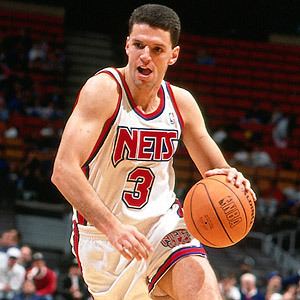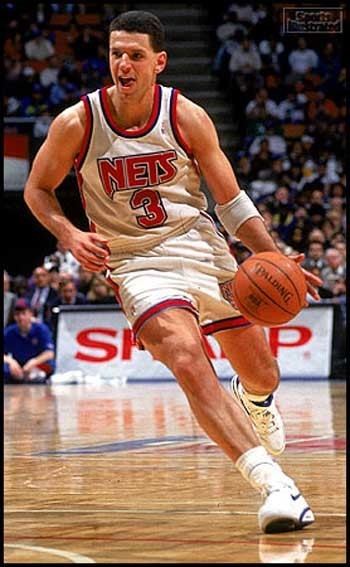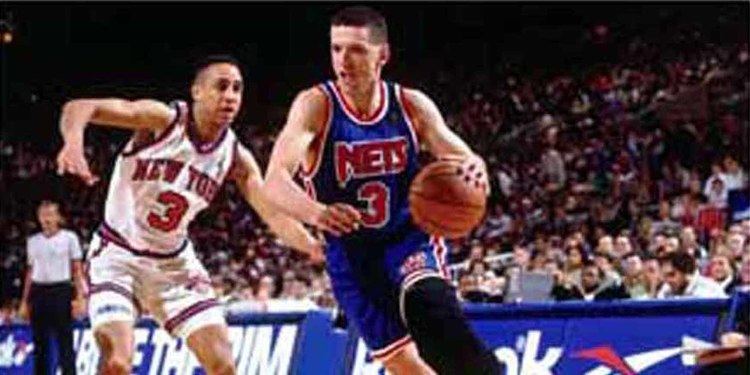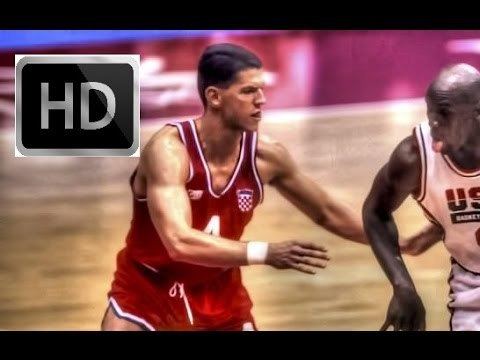Nationality Croatian Position Shooting guard Height 1.96 m Listed height 6 ft 5 in (1.96 m) Number 44, 3, 4, 10, 5 Career start 1979 | Listed weight 200 lb (91 kg) Name Drazen Petrovic Siblings Aleksandar Petrovic Pro career 1979–1993 Role Basketball player | |
 | ||
Parents Jovan Petrovic, Biserka Petrovic Similar People Vlade Divac, Toni Kukoc, Aleksandar Petrovic, Dino Rada, Arvydas Sabonis | ||
Reggie miller says dra en petrovi is the best shooter ever faster release than steph curry
Dražen Petrović ([drǎʒɛn pɛ̌trɔʋit͡ɕ]; October 22, 1964 – June 7, 1993) was a Croatian professional basketball player. A shooting guard, he initially achieved success playing professional basketball in Europe in the 1980s, before joining the National Basketball Association (NBA) in 1989.
Contents
- Reggie miller says dra en petrovi is the best shooter ever faster release than steph curry
- Michael jordan vs dra en petrovi highlights bulls vs nets 1992 03 17 66pts combined
- Early years
- ibenka
- Cibona
- Real Madrid
- Portland
- New Jersey
- National teams
- Death and legacy
- Club competitions
- Draen Petrovi Memorial Center
- References

A star on multiple stages, Petrović earned two silver medals and one bronze in Olympic basketball, a gold and a bronze in the FIBA World Cup, a gold and a bronze in the FIBA EuroBasket, and two EuroLeague titles. He represented Yugoslavia's national team and, later, Croatia's national team. He earned four Euroscars, and was named Mr. Europa twice. In 1985, he received the Golden Badge award for best athlete of Yugoslavia.

Seeking a bigger arena after his career start in Europe, Petrović joined the NBA in 1989, as a member of the Portland Trail Blazers. After playing mostly off the bench that year, Petrović experienced a breakthrough following a trade to the New Jersey Nets. While starting for the Nets, he became one of the league's best shooting guards and was in consideration for being the best shooter ever. Petrović's career and life were cut short after he died in a car accident at the age of 28.

Petrović is considered the crucial part of the vanguard to the present-day mass influx of European players into the NBA. Petrović's #3 was retired by the Nets in 1993, and in 2002, he was posthumously enshrined in the Naismith Memorial Basketball Hall of Fame. In 2013, he was voted the best European Basketball player in history, by players at the 2013 FIBA EuroBasket.

Michael jordan vs dra en petrovi highlights bulls vs nets 1992 03 17 66pts combined
Early years

Born in Šibenik, SR Croatia, SFR Yugoslavia, Dražen Petrović was the second child of Jovan "Jole", a police officer, and Biserka, a librarian. His father, of Serb ethnicity, was born in Zagora, near Trebinje in Bosnia and Herzegovina. His mother was born in Bilica, near Šibenik, and was from a traditional conservative Croat family, devoutly Roman Catholic. The couple's eldest child, Aleksandar, would be the first one to tread the basketball path, providing a lead for his younger sibling. The Petrović siblings are second cousins to the Serbian basketball player Dejan Bodiroga.
Šibenka
At the age of thirteen, Petrović started playing in the youth selections of the local club Šibenka; at the age of fifteen he had already made the first team, just as Šibenka earned a place in the Yugoslav national first division. With young Petrović as the star of the team, Šibenka reached the final of the FIBA Radivoj Korać Cup twice (1981–82 and 1982–83), losing to Limoges CSP both times. In 1983, the 18 year-old Petrović hit two free throws for Šibenka's victory over Bosna in the final playoff game of the Yugoslavian club championship, but the title was taken away from Šibenka the next day by the national basketball federation with irregularities in refereeing cited as the reason, and awarded to Bosna after Šibenka refused to show up for the repeat match.
Cibona
After spending a year serving the mandatory time in the military, Petrović followed his brother's footsteps and moved to Cibona to form, at that time, the best backcourt duo in Europe. The very first year in Cibona he won both the Yugoslav League championship and the Yugoslav National Cup. To top it all off, the 87–78 victory over the Spanish League club Real Madrid, to which Petrović contributed with 36 points, brought him and Cibona their first European Cup title. The second came the following year, as Petrović scored 22 points and Cibona defeated the USSR Premier League club Žalgiris Kaunas, which starred the legendary Arvydas Sabonis. The same year brought another Yugoslav national cup title for Cibona, seeing Petrović score 46 against the old rival Bosna. In 1987, Petrović earned his third European trophy: a 2nd-tier European Cup Winners' Cup title against the Italian League club Scavolini Pesaro, whose net he filled with 28 points.
Petrović's scoring average during the four years with Cibona stood at 37.7 points in the Yugoslavian first division and 33.8 in all of the European wide competitions that he played in, with personal one-time bests of 112 (40/60 FG, 10/20 3Pts, 22/22 FT) in the Yugoslavian League, and 62 points in the 3rd-tier European league, the Korać Cup, respectively. His scoring sheet was often known to show 40, 50, even 60 in a single game; in a 1985–86 season European League game against Limoges, Petrović scored ten 3-pointers, including seven in a row during a first half stretch, for a final tally of 51 points and 10 assists; the same season he scored 45 points and dished out 25 assists against the reigning Italian League champions Simac Milano.
Petrović needed new challenges, which Cibona and the Yugoslavian League could not offer. Across the Atlantic, the Portland Trail Blazers of the NBA had already used their third round pick on young Petrović in 1986. However, he decided to postpone his departure to the United States. In 1988, he signed with Real Madrid instead, for at that time a hefty sum of around US$4 million. The transfer wasn't without controversy as the Yugoslav sporting laws stipulated that players weren't allowed to professionally move abroad until reaching 28 years of age, while Petrović was still only 23 when he signed with the famous Madrid club. In 2014, José Antonio Arízaga, the sports agent who played a key role in Petrović's summer 1988 transfer from Cibona to Real, recalled a few details from this transaction: "I spoke to Mirko Novosel, Dražen's coach at Cibona, and he told me two things. One, every problem in Yugoslavia can be taken care of with the right amount of money, and two, if Dražen leaves, every other player under 28 will be livid and it'll be chaos. So, you can imagine all the individuals I had to bribe and all the places where I had to pay up in order to circumvent this law".
Real Madrid
The 1988–89 season saw Petrović wear the colors of the Spanish ACB League basketball club Real Madrid. Although the Spanish national championship barely escaped them, as they lost to FC Barcelona in the fifth and decisive game of the league's final series, Petrović helped Real to win the Spanish King's Cup title over their Catalonian rivals. Petrović also led the club to victory in the 2nd-tier European Cup Winners' Cup final against the Italian League club Snaidero Caserta by tying his previous best scoring performance in European competitions (62 points). His first season in the ACB was also his last, but he still holds ACB single performance bests in a final series game in points made (42) and three-pointers made (8).
Motivated by the challenge and pressured by the Portland Trail Blazers, who had drafted him 60th overall back in 1986, Petrović finally stood firm in the decision to try to establish himself in the NBA. He left Spain rather abruptly at the end of the season; the Blazers assisted in buying out his contract with Real (for as much as US$1.5 million) and Petrović joined the Blazers for the 1989–1990 season.
Portland
The Blazers valued Petrović as a shooter, but were concerned that he might not possess the quickness to play guard or the foot speed to play defense. They brought him onto the team primarily as an outside threat to shoot three-pointers. In the Blazers' offensive scheme he was to set up behind the line, receive a passed ball and go directly up to release his shot. Petrović was an aggressive, attacking player who was used to creating his shot and shots for his teammates. Taking the ball out of his hands and making him a static shooter was foreign to him. Making matters worse, the Blazers already had a full rotation of guards, with a starting backcourt of Clyde Drexler and Terry Porter, and with veteran Danny Young as a reserve. Consequently, the reigning La Gazzetta dello Sport Euroscar European Player of the Year saw limited playing time. He had difficulty being productive in the limited role the Blazers had for him. In his rookie year during the 1989–90 NBA season, he averaged 7.4 points in 12 minutes playing time per game. The following season veteran guard Danny Ainge was added to the team, and Petrović's playing time dropped further to 7 minutes a game. In many statements made prior to arriving in Portland, Petrović had said he saw a lack of playing time as the only possible obstacle to his success in the NBA. He was determined to be a success in basketball's highest arena. His lack of playing time during his second season in the league brought Petrović's frustration to a climax: "I have nothing to say to Adelman any more and vice versa. Eighteen months have passed by, too long. I have to leave to prove how much I am worth. Never in my life did I sit on the bench and I don’t intent to do that in Portland."
At his insistence, 38 games into the season (20 of which held no playing time for Petrović), a three-way trade with the Denver Nuggets sent him to the New Jersey Nets in exchange for a first-round pick in the following draft and Walter Davis, who was sent from Denver to Portland.
New Jersey
On January 23, 1991, Petrović became a member of the New Jersey Nets. He joined a team that had not reached the playoffs since 1986, but had rookie Derrick Coleman, the number one selection from the 1990 draft. He was immediately given a role on the floor, with 20.5 minutes per game. His scoring over the remaining 43 games increased to 12.6 points per game, one of the league's best points-per-minute ratios. The following year he and Coleman were joined by Kenny Anderson, giving the team a third talented new addition. Petrović was made a starter for the 1991–92 season, his first full season with the Nets. Petro, as the Americans had dubbed him, did not miss a single game. His determination, hard work and aggressive on court demeanor established him as a team leader. In 36.9 minutes on the floor he averaged 20.6 points. Petrovic led the Nets in field-goal shooting and free-throw shooting, and his field goal percentage of 51% placed him near the top of all NBA guards. More importantly, his success translated into success for the team. The Nets made the playoffs, recording 14 more wins than the previous year. The following season saw Petrović increase his scoring average to 22.3 ppg, 11th best in the league. On December 6, he was named MVP of the Week. For the second season in a row he shot 45% from the three-point arc. His field goal percentage of 52% was again near the top for all guards. American media honored him with a selection to the All-NBA Third Team. However, he did not receive an invitation to the 1993 All-Star game. Among the top 13 scorers in the NBA that season, he was the only one not invited.
National teams
Petrović's national team debut came at the age of 15, at the Under-18 Balkan Championship in Turkey, where the Yugoslavian junior team won the bronze. The young man regularly played for the Yugoslavian national team in the Balkan Championships, also winning gold with the junior team and silver with the senior team. He also brought back the silver from the 1982 FIBA Europe Under-18 Championship in Bulgaria.
The 1984 Summer Olympics were Petrović's first competition of a grand scale with the Yugoslav senior national team, and the bronze medal won in Los Angeles that summer became his first Olympic medal. Third place was also earned at the 1986 FIBA World Championship, remembered for the last minute thriller in the semi-final game against the Soviet Union. At the 1987 EuroBasket, Petrović again returned with bronze, as Yugoslavia lost to the hosts and gold medalists Greece. The University Games, held in Zagreb in 1987, saw the Yugoslavian squad with Petrović win the gold. In the 1988 Summer Olympics, Yugoslavia with Petrović, earned 2nd place, as they lost once more to the Soviet powerhouse.
An excellent club season with Real Madrid was topped by Petrović's 1989 accomplishment with the Yugoslav national team: at the EuroBasket in Zagreb, the young Yugoslavian team went all the way, defeating Greece more than comfortably in the championship game. Petrović was the tournament's second leading scorer and most valuable player. The very next year, the summer in between the two most frustrating seasons of his professional career, as he struggled for playing time with the Trail Blazers, Petrović was again making history with the national team, as Yugoslavia became world champions, after beating the Soviet Union for the gold in Buenos Aires, at the 1990 FIBA World Championship.
The 1992 Olympic Games in Barcelona, marked the first summer Olympiad featuring the independent Croatia, and Petrović was the leader of the Croatian national basketball team at the Olympic basketball tournament. Losing only to the American Dream Team in round-robin play, a strong and inspired Croatian team emerged victorious from the semi-final against the revamped Soviet team, thanks to clutch free throws executed by Petrović, and faced off against the Americans for the gold. Urged on by Petrović's competitiveness and confidence, the Croatians fared well in the first ten minutes of the game, taking a 25–23 lead on a Franjo Arapović dunk and the subsequent free throw. As the game progressed, however, the now-legendary team composed of NBA stars proved too tough for Croatia: the Americans won 117–85, sending Petrović, the game's leading scorer with 24 points, and his teammates, home with silver medals.
In the period during which Petrović played for the Croatian national team (from 1992 to 1993), he appeared in 40 games and scored 1,002 points. His highest point tally came against Estonia, on 31 May 1993 (48 points).
Death and legacy
In the summer of 1993, after his best NBA season and the Nets' first-round elimination by the Cleveland Cavaliers, Petrović traveled to Poland, where the Croatian national team was playing a qualification tournament for the 1993 EuroBasket. He was contemplating departure from the Nets, disappointed with tension between himself, and in his belief, envious teammates, as well as the fact that the Nets had not yet extended his contract. He told American reporters that the lack of recognition in the league had him also considering leaving the NBA completely and playing club basketball in Greece; there were at least two Greek clubs ready to offer Petrović three-year contracts worth US$7.5 million net. It was rumored that Petrović verbally agreed on terms with Panathinaikos; these rumors gave rise to the story of PAO's owner, Pavlos Giannakopoulos, allegedly offering the Nets' star a signed contract with blank salary terms, which became a part of Petrović's legend. Petrović decided to skip the connection flight back to Zagreb and drive with his girlfriend back to Croatia.
Petrović died in a traffic accident at approximately 17:20 on June 7, 1993, four and a half months before his 29th birthday. On the rain-drenched Autobahn 9, he was a passenger in a car that was cut off by a semi truck at Denkendorf, near Ingolstadt, in the German state of Bavaria. According to the report of the Ingolstadt police, that afternoon a truck broke through the Autobahn median; the truck driver was trying to avoid a collision with a personal vehicle in his own lane and lost control of the truck, crashing through the median barrier and finally coming to a stop blocking all three lanes of traffic in the opposite direction (Munich). Seconds later, the VW Golf carrying a sleeping Petrović in the passenger seat crashed into the truck, killing him and leaving the driver, Klara Szalantzy, a Hungarian model and basketball player with whom Petrović was romantically involved, and Hilal Edebal, a female Turkish basketball player, with grave injuries. It was established that visibility on the road was very poor and that Petrović was not buckled with a seatbelt.
Petrović's tomb 45°50′22″N 15°59′00″E at Mirogoj Cemetery instantly became a sanctuary for his compatriots. The Cibona stadium was renamed the Dražen Petrović Basketball Hall on October 4, 1993, and the city of Zagreb dedicated a square in his name, which was later followed by Šibenik and Vukovar, while Petrinja dedicated him a street. The Nets retired his number 3 jersey on November 11, 1993. After 1994, the MVP award at the McDonald's Championship had borne the name Drazen Petrovic Trophy, and the Croatian Olympic Committee's award for young athletes has borne his name since 2006. On April 29, 1995, a statue commemorating Petrović's significance to the world of sports was erected in front of the Olympic Museum in Lausanne, Switzerland, thus making him only the second athlete to receive this honor. On July 9, 2001, having defeated Patrick Rafter to win the men's singles title at Wimbledon, Croatian tennis player Goran Ivanišević dedicated the win to his late friend Petrović; Ivanišević wore Petrović's Nets jersey amidst the 100,000 strong crowd celebrating his victory in Split. Petrović was inducted posthumously into the Basketball Hall of Fame in 2002. In 2006, the 13th anniversary of Petrović's death was marked with the opening of the Dražen Petrović Memorial Center in Zagreb, dedicated to his life and achievements, with ten themed galleries of multimedia content outlining his entire career and a four meter high statue of Dražen in shooting position in front of it. Petrović was enshrined in the FIBA Hall of Fame in 2007.
The 2010 documentary, Once Brothers (part of the ESPN 30 for 30 series), portrays the achievements of the Yugoslavia national basketball team in the late 1980s and early 1990s, and how the Yugoslav Wars tore the team apart. It explores Petrović's broken friendship with Serbian/Yugoslav player Vlade Divac. In 2011, a statue of him as a little boy sitting on a bench with a ball was unveiled in Šibenik, and his old room was renovated the way it looked when he was young, as a first part of opening a Memorial Center in his hometown. During the 2012 Three Point Shootout, New Jersey Nets guard Anthony Morrow wore Petrović's jersey in the latter's honor. In 2015, Australian writer Todd Spehr released a 470-page biography on Petrović, Dražen: The Remarkable Life & Legacy of the Mozart of Basketball. On June 3, 2015. Croatian basketball journalists Marjan Crnogaj and Vlado Radicevic released a 487-page (462 footnote) unofficial biography which is currently still available only in Croatia but is expected to be released worldwide in December 2016.
Club competitions
National teams
Dražen Petrović Memorial Center
A museum named "The Dražen Petrović Memorial Center" was founded in his honor, and constitutes a co-operative effort led by the Dražen Petrović Foundation in conjunction with the Croatian government, the city of Zagreb and the Croatian Museum of Sports. The memorial center idea originated from Petrović's parents, Biserka and Jole Petrovic, and was supported with the contributions of Croatian architects Andrija Rusan and Niksa Bilic. All of the articles presented in the center have been collected and categorized by the Croatian Museum of Sports. The organization and operations of the center have been provided by the Dražen Petrović Foundation, which is led by Petrović's family. The Center contains his No. 3 New Jersey Nets jersey and the watch that stopped when he died in a car crash. The center features 1,000 memorabilia items and a video of his basketball highlights.
The official opening of the museum was held on June 7, 2006, while the official opening of the center to the public began at the end of December 2006. The square on which the center is operated upon has been renamed to Dražen Petrović Square in his honor. In 2013, former NBA MVP Derrick Rose visited the museum.
